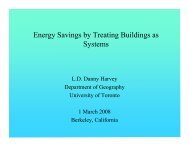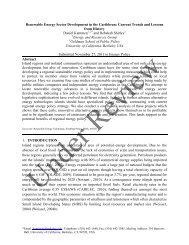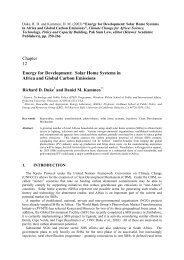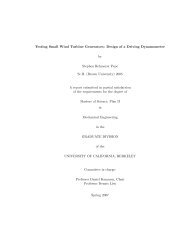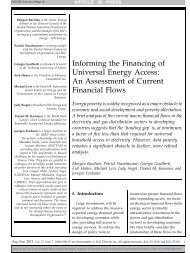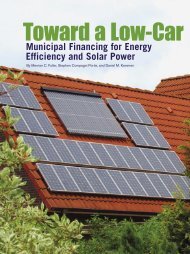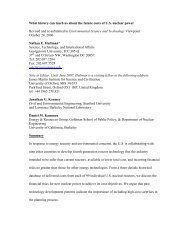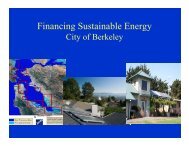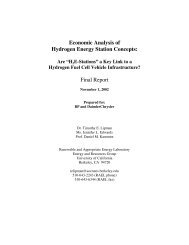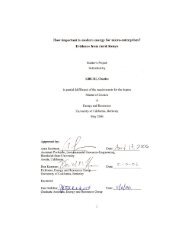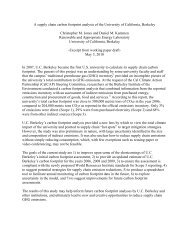Environ. Res. Lett. 8 (2013) 014038M Wei et alFigure 4. Average 2050 electricity generation by fuel category, <strong>and</strong> average 2050 power cost (<strong>in</strong> $2007 per MWh) for ten electricityscenarios <strong>in</strong> which WECC-wide power sector emissions are capped at 80% below 1990 levels. The biomass solid CCS scenario <strong>in</strong>cludesfurther GHG <strong>reductions</strong>. The frozen, no <strong>carbon</strong> cap scenario does not <strong>in</strong>clude a cap on GHG emissions. The compliant case (‘Base Case’) isthe start<strong>in</strong>g po<strong>in</strong>t on which other sensitivity scenarios are based. Information on specific scenarios can be found <strong>in</strong> the supplementarymaterial (available at stacks.iop.org/ERL/8/014038/mmedia). The average power cost varies by less than $20 per MWh across GHG-cappedscenarios, <strong>in</strong>dicat<strong>in</strong>g that many low-cost, low-GHG options exist for the power sector.dem<strong>and</strong> flexibility could <strong>in</strong>centivize either w<strong>in</strong>d or solarpower, depend<strong>in</strong>g on their relative delivered costs.Us<strong>in</strong>g operat<strong>in</strong>g reserve <strong>require</strong>ments <strong>and</strong> large balanc<strong>in</strong>gareas similar to those evaluated <strong>in</strong> the Western W<strong>in</strong>d <strong>and</strong>Solar Integration Study [26], we f<strong>in</strong>d that the majority ofsp<strong>in</strong>n<strong>in</strong>g reserves <strong>in</strong> WECC can be provided by hydroelectricpower <strong>and</strong> storage technologies, with the balance providedby gas-fired technologies. Sub-hourly load balanc<strong>in</strong>g does notappear to be a major limitation for achiev<strong>in</strong>g deep emissionsreduction <strong>in</strong> a future electricity grid with up to 60% of energyfrom variable renewable generation.Nuclear power <strong>and</strong> fossil fuel generation with CO 2capture <strong>and</strong> sequestration (fossil/CCS) may be attractivelow-GHG baseload technologies, but neither is essential tomeet<strong>in</strong>g GHG targets (figure 4). With the costs assumed <strong>in</strong>this study, generat<strong>in</strong>g electricity from fossil/CCS can lowerthe cost of power while meet<strong>in</strong>g emissions targets. Installationof new nuclear power is found to be a backstop aga<strong>in</strong>st ris<strong>in</strong>gpower costs, but is not cost-effective given our base costassumptions.Greater fractions of energy from variable renewableresources are found to <strong>in</strong>crease the magnitude of transmission<strong>and</strong> storage deployment (figures S69 <strong>and</strong> S71 availableat stacks.iop.org/ERL/8/014038/mmedia). Power systems <strong>in</strong>this study that generate less than half of their electricityfrom variable renewable resources are not found to needdrastic expansion of the transmission system nor large-scaledeployment of electric energy storage. However, as thefraction of electricity from variable renewable resourcesexceeds fifty per cent, <strong>in</strong>creas<strong>in</strong>g amounts of transmission<strong>and</strong> storage are <strong>in</strong>stalled <strong>in</strong> order to spatially <strong>and</strong> temporallymove electricity from the po<strong>in</strong>t of generation to the po<strong>in</strong>t ofconsumption.The average cost per MWh of electricity stays relativelyconstant between present day <strong>and</strong> 2050 across a range ofcost <strong>and</strong> generator availability scenarios. While this resultis <strong>in</strong> part dependent on technological improvement driv<strong>in</strong>gdecl<strong>in</strong><strong>in</strong>g capital costs, sensitivity analyses show that threefuture supply options with the most uncerta<strong>in</strong> costs—solarphotovoltaics, nuclear, <strong>and</strong> fossil/CCS—are not <strong>in</strong>dividuallyessential to keep the cost of electricity low. In all scenarios,total power system cost <strong>in</strong>creases roughly <strong>in</strong> proportion toload, so while <strong>in</strong>creas<strong>in</strong>g dem<strong>and</strong> adds to total expenditures,the average cost per MWh is stable through 2050. Relative toa scenario <strong>in</strong> which no cap on GHG emissions is enforced,achiev<strong>in</strong>g 80% GHG <strong>reductions</strong> <strong>in</strong> the power sector raises thecost of power by 18%–42%. The tight range of power systemcosts found amongst a variety of scenarios (figure 4) <strong>in</strong>dicatesthat GHG reduction via <strong>electrification</strong> is a robust strategy, asthe risk of power cost overruns is reduced by the availabilityof a portfolio of technologies.6. Discussion—the need for <strong>in</strong>tegrated plann<strong>in</strong>g <strong>and</strong>policyLong-range plann<strong>in</strong>g can ensure that current policies <strong>and</strong>pathways are consistent with long-term goals. Policies thatfocus on improv<strong>in</strong>g natural gas heat<strong>in</strong>g or conventional<strong>in</strong>ternal combustion eng<strong>in</strong>e efficiency without transition<strong>in</strong>gaway from fossil fuel may be appropriate for the shortterm, but are not sufficient for meet<strong>in</strong>g long-term GHGtargets. Similarly, the <strong>electrification</strong> of heat<strong>in</strong>g will only bean effective measure for meet<strong>in</strong>g an 80% reduction goalif the electricity supply has a near zero-GHG <strong>in</strong>tensity.The <strong>in</strong>teraction among different sectors <strong>and</strong> various GHGreductionpathways should cont<strong>in</strong>ue to be an active area ofresearch <strong>and</strong> optimization.Technology does not appear to be the limit<strong>in</strong>g factor forthe State to meet its economy-wide 2050 GHG emissions7
Environ. Res. Lett. 8 (2013) 014038target, though this conclusion is predicated upon amplelow-GHG biomass supplies (with little or no associated<strong>in</strong>direct l<strong>and</strong> use impacts), steady technological development<strong>and</strong> cost reduction of exist<strong>in</strong>g technologies, <strong>and</strong> moremodest economic growth than assumed <strong>in</strong> other studies [5,6]. Much of the technology already exists for <strong>in</strong>creased<strong>electrification</strong> <strong>and</strong> build<strong>in</strong>g efficiency, but may need policysupport to achieve cost-effective production at scale <strong>and</strong>more importantly, to <strong>in</strong>duce widespread adoption (tables S1<strong>and</strong> S2 available at stacks.iop.org/ERL/8/014038/mmedia).Plug-<strong>in</strong> electric vehicles are be<strong>in</strong>g rapidly developed bythe automotive sector, but there is less activity <strong>in</strong> othertransportation sectors. Availability of biomass <strong>and</strong> low-GHGprocess development are pivotal for reduc<strong>in</strong>g fuel-use GHGemissions.In addition to technological solutions, substantial<strong>reductions</strong> are also possible from conservation measures [27].Prelim<strong>in</strong>ary model<strong>in</strong>g of these GHG-sav<strong>in</strong>g measures wasconducted based on historical trends <strong>in</strong> non-energy behaviors<strong>in</strong>clud<strong>in</strong>g public health, safety, <strong>and</strong> diet. By 2050, as much as16% of GHG emissions could be conserved by measures suchas <strong>reductions</strong> <strong>in</strong> vehicle-miles traveled, eco-driv<strong>in</strong>g, <strong>in</strong>creasedenergy conservation, improved diets, waste reduction, <strong>and</strong><strong>in</strong>creased recycl<strong>in</strong>g (section 9, supplementary materialavailable at stacks.iop.org/ERL/8/014038/mmedia). Human<strong>and</strong> social factors should be a topic for further research,as they are directly coupled with public policy, technologydeployment, <strong>and</strong> market development.Expansion of <strong>California</strong>’s policy framework is needed toenable energy system changes suggested here<strong>in</strong>. Aggressivecodes <strong>and</strong> st<strong>and</strong>ards will be <strong>require</strong>d to meet build<strong>in</strong>g, vehicle,<strong>and</strong> <strong>in</strong>dustry efficiency targets. While efficiency is already afocus for the State, implementation <strong>and</strong> adoption of additionalefficiency measures is critical, especially for build<strong>in</strong>g retrofits.Policies are currently <strong>in</strong> place for both vehicle <strong>electrification</strong><strong>and</strong> low-GHG biofuels, but will need extension <strong>and</strong> expansionto meet the 2050 climate goal. Multiple barriers exist forbuild<strong>in</strong>g <strong>electrification</strong>, <strong>and</strong> policy development is urgentlyneeded to ensure the transition to electrified heat<strong>in</strong>g. An 80%reduction <strong>in</strong> electricity sector emissions can be ensured witha cont<strong>in</strong>uation <strong>and</strong> expansion of aggressive renewable energy<strong>and</strong>/or GHG targets <strong>in</strong> the future.Meet<strong>in</strong>g the State’s 2050 GHG target is found tobe feasible but <strong>require</strong>s a portfolio of measures <strong>and</strong> acommitment to <strong>in</strong>tegrat<strong>in</strong>g <strong>and</strong> coord<strong>in</strong>at<strong>in</strong>g policies <strong>in</strong> theelectricity, build<strong>in</strong>gs, transportation, <strong>and</strong> <strong>in</strong>dustrial sectors.The GHG reduction measures put forward here <strong>in</strong>clude an<strong>in</strong>crease <strong>in</strong> the efficiency of energy use for all sectors, adrastic decrease <strong>in</strong> the GHG <strong>in</strong>tensity of electricity <strong>and</strong> liquidfuels, <strong>and</strong> a substitution of end-use fuel consumption forelectricity. Behavioral factors may also be able to play animportant role <strong>in</strong> GHG emission reduction. Long-term policysupport is found to be a key miss<strong>in</strong>g element for the successfulatta<strong>in</strong>ment of the 2050 GHG target <strong>in</strong> <strong>California</strong>.7. Materials <strong>and</strong> methodsFuture electricity <strong>and</strong> fuel dem<strong>and</strong>s were projected forthree economic sectors (build<strong>in</strong>gs, transportation, <strong>and</strong>M Wei et al<strong>in</strong>dustry) with piecewise additive scenarios for energydem<strong>and</strong> <strong>and</strong> energy supply. First, energy efficiency isapplied across sectors, then clean electricity is added,followed by <strong>electrification</strong>, low <strong>carbon</strong> biofuels, <strong>and</strong> thenenergy conservation. Electricity <strong>and</strong> fuel supply mixeswere developed to meet overall dem<strong>and</strong> subject to biofuelavailability <strong>and</strong> GHG constra<strong>in</strong>ts for electricity. GHGemissions were calculated for each scenario based onoverall energy dem<strong>and</strong>s <strong>and</strong> <strong>carbon</strong> <strong>in</strong>tensity of energysupplies. Assumptions for the boundaries <strong>and</strong> scope ofGHG emission treatment are discussed <strong>in</strong> the supplementarymaterial (available at stacks.iop.org/ERL/8/014038/mmedia).Energy dem<strong>and</strong> for a frozen efficiency case was firstestimated as a reference case with growth rates <strong>in</strong>formedby historical trends <strong>and</strong> other studies. An energy efficiencycase was then developed assum<strong>in</strong>g that technical potentiallevels of efficiency are achieved across all three sectors.A low-GHG electricity supply was added to this scenario(energy supply model<strong>in</strong>g is described below). Fuel-switch<strong>in</strong>gwas <strong>in</strong>troduced by assum<strong>in</strong>g wide spread <strong>electrification</strong> fromgasol<strong>in</strong>e-based <strong>in</strong>ternal combustion eng<strong>in</strong>es to electrifiedor partially electrified passenger vehicles <strong>and</strong> from largelynatural gas based heat<strong>in</strong>g processes to electrified heat<strong>in</strong>g<strong>in</strong> build<strong>in</strong>gs <strong>and</strong> <strong>in</strong>dustry. Further <strong>carbon</strong> reduction wasachieved by assum<strong>in</strong>g technical potential availability of liquidbiofuels <strong>and</strong> f<strong>in</strong>ally by assum<strong>in</strong>g conservation measures areaggressively adopted.Energy dem<strong>and</strong> was disaggregated <strong>in</strong>to build<strong>in</strong>g, transportation,<strong>and</strong> <strong>in</strong>dustry sectors for <strong>California</strong>. Estimatesutilized a median population <strong>and</strong> economic growth forecastbased on State <strong>and</strong> <strong>California</strong> Energy Commission (CEC) estimates,respectively. Build<strong>in</strong>g dem<strong>and</strong>s for electricity <strong>and</strong> fuel(e.g., natural gas for heat<strong>in</strong>g) were developed for residential<strong>and</strong> commercial build<strong>in</strong>gs as described <strong>in</strong> the supplementarymaterial (available at stacks.iop.org/ERL/8/014038/mmedia)<strong>and</strong> further disaggregated <strong>in</strong>to s<strong>in</strong>gle/multi-family units <strong>and</strong>new/exist<strong>in</strong>g build<strong>in</strong>gs. Stock turnover analysis was donefor a comprehensive set of end-use dem<strong>and</strong>s. Commercialbuild<strong>in</strong>gs dem<strong>and</strong> estimates utilized historical trends ofenergy dem<strong>and</strong> per square foot of space by build<strong>in</strong>g type.Electricity dem<strong>and</strong> for the rest of the Western ElectricityCoord<strong>in</strong>ation Council geographic region was estimated from asynthesis of US Energy Information Adm<strong>in</strong>istration data <strong>and</strong>regional utility forecasts.Transportation dem<strong>and</strong> estimates utilized vehicle stockmodel<strong>in</strong>g for passenger vehicles <strong>and</strong> aviation with projectionsfor other transportation modes consistent with State orfederal models. Stock model<strong>in</strong>g assumptions of vehiclesper capita, vehicle-miles travelled (VMT) per vehicle, <strong>and</strong>market penetrations by vehicle drivetra<strong>in</strong> (<strong>in</strong>ternal combustioneng<strong>in</strong>es, hybrid electric vehicles, plug-<strong>in</strong> hybrid vehicles, <strong>and</strong>battery electric vehicles) are described <strong>in</strong> the supplementarymaterial (available at stacks.iop.org/ERL/8/014038/mmedia).Industry dem<strong>and</strong> estimates employed sector-based (oil <strong>and</strong>gas, food <strong>and</strong> beverage, etc) economic growth projectionsfrom the CEC.The energy efficiency scenario utilized technical potentialestimates for each sector. The build<strong>in</strong>g sector employed8



